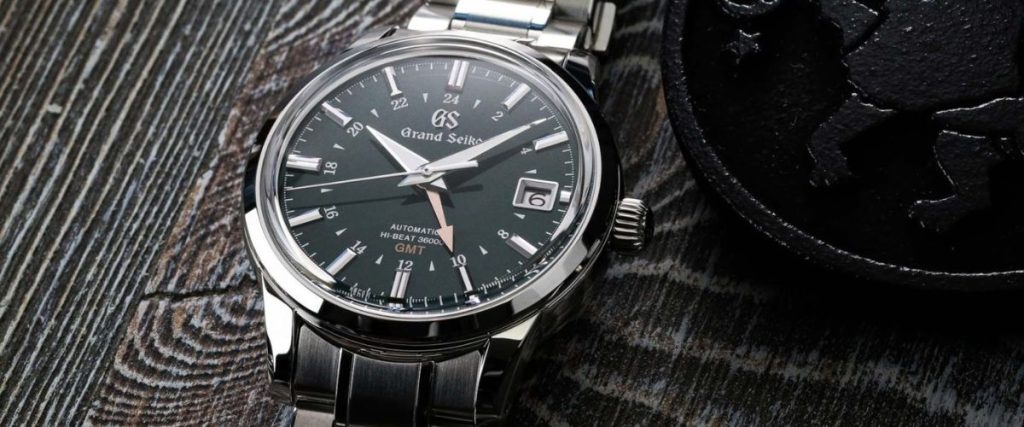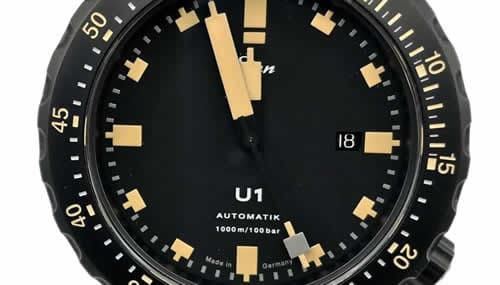
Grand Seiko SBGJ251 Review – Inspired by the Spring Equinox
Back in 2020, traveling, either with or without a GMT watch strapped to your wrist, was beginning to feel like a distant memory for many of us.
But in the years following the pandemic, the demand for GMT watches and the desire for a holiday returned with full force, putting brands like Grand Seiko right at the forefront of that need. Why, you ask? Because Grand Seiko does a superb GMT watch. That’s why today we’ll be looking at the reference SBGJ251 – the “Shunbun”.
What Is a GMT Watch?

Maybe you spend a lot of your working week at a desk organizing overseas conference calls and confusing greetings of “Good Morning” with “Good Evening” because, let’s face it, keeping track of multiple time zones across the world is not easy.
Or maybe you travel frequently on business? Either way, there’s a good chance you’ll have pondered buying a watch for travel to assist with your organizational skills. Maybe you own several already, and you’re looking to expand your collection with another?
Either way, travel watches are considered a necessity by many luxury watch enthusiasts since they’re multifunctional, and they look so stylish.
There are different layouts and names used for travel watches, but the most common is the GMT. The name “GMT” derives from Greenwich Mean Time – the local mean time at Greenwich, London, by which other countries in the world use as a zero reference point to determine whether they are “X” amount of hours ahead or “X” amount of hours behind.
This style of watch features a fourth hour hand that relays the time in a different location of the world. More often than not, this special hand is highlighted in a vibrant color or tipped with a triangular motif, enabling you to quickly distinguish it when looking at home time versus current time.
Many GMT watches also feature a bi-color (or two-tone) bezel to help you differentiate between daytime and night-time hours in the 24-hour format, but not all, as we’ll soon see in the design of the Grand Seiko “Shunbun”.
In a nutshell, GMT watches are a very practical complication, owing to their immense popularity across the watch-collecting community. People love the distinctive style of these travel watches and the value they bring to the wrist on a functional level.
The magic of reading a watch like the SBGJ251 is that you can read the time in two different time zones. You can check the time where you currently are and compare it to where you were at a glance. In all the brand’s main collections, you can find a GMT watch.
Some examples include the sporty SBGJ237, with a striking blue and white 24-hour bezel, or the SBGJ021, with a deep rusty red dial and a peach-colored travel hand. Case in point, GMT watches come in many varieties, styles, and colors.
The History of the SBGJ251
To understand why the reference SBGJ251 is one of the most popular GMT watches to collect from Grand Seiko’s ever-evolving range, we need to look at the origins of the collection. Back in 2019, the watchmaker released four different but equally stunning designs, forming the entrancing Four Seasons watch collection, with dials inspired by nature itself.
Anyone already familiar with Grand Seiko will know that the Japanese watchmaker has based many of its most elegant timepieces on elements taken from the natural surroundings of its prestigious Shinshu Watch Studio.
In particular, the models from the Four Seasons collection focus on the changing seasons and the transitional periods between those months. The Grand Seiko SBGJ251 became part of this story.
The Four Seasons Collection
The Four Seasons collection first came into existence with the launch of those four very important models. Each one took direct inspiration from the four seasons of the year: Spring, Summer, Autumn, and Winter.
For some background to this review, those models include the “Shunbun”, highlighted by the gentle pink-colored blossoms that fall from the cherry blossom tree into the water on a Spring morning.
Also, the “Rikka” timepiece reflects the rich green shades of the luscious land across Japan when ripples of grass dance in the warm Summer winds. For Autumn, Grand Seiko chose the “Shubun” timepiece – a dial inspired by the dimming light of dusk and the arrival of a moonlit sky in The Fall during the autumnal equinox. The Grand Seiko “Taisetsu” was a timepiece that captivated its wearer with a dial evoking the silences of fallen, glistening slowly in Winter.
These models, released in 2019, are based on the 62GS design, but one of the most alluring features of those first four designs is that they follow the Japanese concept of “Sekki”.
Rather than viewing the phases of the year in four set blocks, the models within the Four Seasons collection detail the 24 individual phases of the year – 6 phases for each quarter.
The Elegance DNA
The Four Seasons models belong to a much larger design concept, Grand Seiko’s Elegance collection. While the Sports collection from Grand Seiko offers slightly more aggressive models (with sharp angles that capture the ever-popular steel sports watch aesthetic) and the Heritage collection honors some important historical landmarks for Grand Seiko – the Elegance collection is somewhat different. In this series, you can find classic dress watch styles, like the SBGJ251, that are perfect for formal occasions and special events.
That said, the Elegance line is also one of the most overlooked of Grand Seiko’s categories. For reasons unknown, they sometimes fly under the radar. Thanks to the level of finishing in one of these Grand Seiko watches and the superior materials used in every design, they also make for great daily beaters!
Here, we arrive at the Grand Seiko “Shunbun” SBGJ251. A daily-wearer with dress watch aesthetics that is also a GMT, inspired by an important part of the year – the Spring Equinox.
My Review of the Grand Seiko SBGJ251 “Shunbun”
The Grand Seiko SBGJ251 “Shunbun” was released in 2021 and, in my opinion, perfectly sums up the spirit and elegance of the Four Seasons collection, taking influences from nature and re-writing the notion of the modern dress watch. The model is refined and classic but with a very functional advantage in that it combines a GMT complication. Here’s a more detailed look at the watch after some time spent handling it.
The Case
One thing I really like about this model is how Grand Seiko opts for a boxed sapphire crystal glass. What that does is it allows the hands to sit further into the crystal cavity and creates the impression, from some angles, that the hands are almost floating. This is a more costly finish than a standard glass fitting.
While standard glass fronts may measure a thickness of around 2-3mm, a boxed sapphire arrangement will actually take up around double that much in thickness. Grand Seiko experts will require the skill of a CNC machine to shave and shape the crystal. Understandably, all of this adds to the manufacturing costs of a Grand Seiko, but simultaneously, it goes some way to achieving a unique and sought-after design.
One drawback of sapphire crystal compared to acrylic crystal, however, is that it doesn’t boast the same level of clarity. Like many luxury watch manufacturers, Grand Seiko remedies this by adding layers of anti-reflective technology to the surface of the glass, promising a clear and crisp view of the SBGJ251 model’s mesmerizing green dial.
Now, let’s move on to the proportions of the watch. The stainless steel case of the SBGJ251 “Shunbun” measures a diameter of 39.5mm, making for a considerably compact size for those with small-ish wrists. The 30-meter water-resistant case has an unusually thick caseback, even for Grand Seiko standards, measuring 14.1mm thickness.
I’ll talk a little more about how that impacts the wrists a little later on. But overall, this is a classically inspired, albeit modern watch, which Grand Seiko experts manage to balance perfectly. On the one hand, the shape and layout of the dial are traditional-looking, but on the other, those Zaratsu polished finishes evoke an unequivocally modern presence.
Zaratsu polishing is a case finish that, in my opinion, supersedes a lot of the more common executions you see on timepieces of a similar price. Quite simply, the finishing is next level. This complicated and sophisticated polishing process is responsible for the razor-sharp, angular polishes that you see across the surface of this case.
They elevate the design to a resolutely dressy style while at the same time reflecting and playing with light in a rather unique way. The technique takes its name from an old European machine called Sallaz and helps define all the flat, sharp edges of the case, not to mention adding a distortion-free mirror finish to the design. This is no easy skill to learn, often requiring a craftsman to undergo several years of extensive training before the art is properly mastered.
Lastly, by flipping the watch over to reveal its underside, a sapphire exhibition feature reveals a beautifully manufactured and decorated movement. The in-house arranged Calibre 9S86 performs behind this window, showing off its fine finishes, including a customized Grand Seiko rotor.
The Dial
One thing I love about GMT watches is that you often get a twist of color in the design. Sometimes, it’s in the form of a bi-color bezel, like I mentioned earlier. Sometimes color is simply offered in the form of the GMT hand or the subtle lettering of the display.
But in the case of the Grand Seiko “Shunbun” watch, the color of the dial is an entrancing deep green hue – an organic, almost-earthy green tone that fills the dial right up to the very perimeters. The color, once again, nods to the brand’s affinity to nature.
The location where Grand Seiko’s prestigious Shinshu Watch Studio is located is surrounded by layers of rich green foliage and mountainous landscapes, some mountains of which reach right up to 3,190 meters high, so you can imagine the blanket of green that bursts into abundant color during Springtime.
Since the Hotaka mountain range that forms the backdrop to the watchmaking studio was formed as a result of volcanic activity, the peaks and slopes are sheer and abstract. The winds, moisture, and natural weather conditions have shaped and carved the structures that form these sharp ridges.
They are exposed to harsh natural elements and the transitional seasons as they roll out across the land. For Grand Seiko, the turning of the seasons is an important source of inspiration for its many watches. The SBGJ251 puts considerable focus on the arrival of the Spring equinox, when Sakura blossoms decorate the land and cherry blossoms begin to bloom.
It’s impossible to discuss the design of the Grand Seiko SBGJ251 and its functional, highly legible qualities without touching on the luscious green blooms of springtime. The watch represents the time in an indulgent pine green color. Interestingly, the matte finish of the dial looks very similar to the texture that Grand Seiko specialists used for the Snowflake watch.
At the 12, 9, and 3 o’clock positions, the hour locations are represented in double batons. The faceted edges of the remaining markers take up residence around the rest of the dial, catching the light majestically under the watch’s protective sapphire crystal glass front, as do the dauphine-shaped hour and minute hands.
The applied Grand Seiko logo and brand name can be seen at the top of the dial in a brushed silver color. It is these smaller details that give the SBGJ251 such character. The GMT scale proves particularly legible, too, including the 24-hour track in silver and the matching triangular markers that go with it.
Suffice it to say, this is no plain green dial. The fine structure of the display changes nuances in the light depending on the angle from which you view it. Given the fact that a love for horology is often multi-faceted, the same can be said for features like this dial. The details begin to unravel themselves the more you admire them.
The Movement
Inside the case of the SBGJ251 lies the automatic Calibre 9S86 – a Hi-Beat movement that contains a total of 37 jewels and performs at a rate of 36,600 vibrations per hour. The Hi-Beat takes its name from the fact that it performs an impressive 10 beats per second.
The movement traces its heritage back to the year 1968 when Grand Seiko released the first self-winding watch with this 10-beat technology. What set a new standard for the Hi-Beat movement, however, was the launch of the Calibre 9S85 almost forty years later. It promised a new level of durability, precision, and reliability from which the 9S86 took over.
The PS86 Calibre also stores a power reserve of 55 hours once fully wound and promises an accuracy of –3 and +5 seconds per day. The beauty of this movement is that when you want to change the time zone, you can do so without jeopardizing the accuracy of the time. To simply set the time, pull the crown out to one notch and adjust the hour hand.
The seconds hand will continue to perform without interruption. The Hi-Beat maintains exceptional precision, both in the essence of timekeeping and in the form of the added hour 24-hour hand.
The Strap
Pairing any travel watch with a stainless steel bracelet will give it a classic and understated look, and that’s certainly what Grand Seiko was going for when designing this model. The 5-link design has a matte finish on the outer links, while brushed finishes have been applied to the central links.
Explore the
Biggest Pre-Owned Collection of Luxury Watches
The simple foldable clasp, manufactured in-house by Grand Seiko, has pushers but, unfortunately, no micro-adjustment system. Maybe it would have been a nice feature for GS to incorporate. Still, it’s not a deal breaker.
How It Wears
Putting the Grand Seiko “Shunbun” reference SBGJ251 on the wrist for the first time will give you an instant feeling of refinement and luxury. After all, these are qualities that the Japanese brand became renowned for during the 1960s.
Even so, as refined as it may be, this watch is perfect for wearing every day of the week, thanks to its robust, solid-feeling stainless steel bracelet. It’s also dressy enough to pair with formal attire or something smarter in the evening.
I already outlined the dimensions of the watch earlier, but one element that may take a little time to get used to is the back of the case. The combination of the bulbous back and the kettlebell bulge at the side of the case does make for thicker wear on the wrist.
This is an interesting concept since Grand Seiko watches tend to be geared towards slimmer, ergonomically-fitting timepieces. In some ways, the bulge of the case and underside nods to a touch of nostalgia, capturing a feel of sporty dress watches from yesteryear.
The GMT feature is a super handy complication that, even at a glance, will provide you instantly with the same at home and in your current location. The main sword-shaped hands and the baton indexes are clear and ultra-legible, enhancing the watch’s wearability factor. At the same time, the GMT hand pointing to the silver 24-hour track is offered up willingly, thanks to the peach-colored tones of the arrow-tipped hand.
The lugs of the SBGJ251 have a downward curvature that turns into the bracelet as they hug the shape of the wrist. I also like the mixture of polished and brushed finishes on the links and the GS-engraved deposit clasp, complete with a milled finish.
The Price
The Grand Seiko “Shunbun” watch reference SBGJ251 comprises a mechanical engine that beats at 36,600 oscillations per hour. That alone is no mean feat, but when you think about the whole package; the level of case finishing, the striking green dial, and the well-executed components of the display – these compounding features reflect a very reasonable price tag of $6,800 on authorized dealers like Exquisite Timepieces.
For $6k and under, you can drop on a pretty neat watch, don’t get me wrong. There are hundreds of options out there. Some that spring to mind are the Omega Seamaster, the Breitling Navitimer, and the Baume et Mercier Clifton, for example. (All these revered names have specialized in the classic sports watch.)
But when it comes to an in-house movement and additional complications like the GMT, and even those signature Zaratsu polished elements – Grand Seiko, for me, wins hands down.
Final Thoughts
My final thoughts on the Grand Seiko SBGJ251 are that this is a unique design that sits somewhere in between sporty and dressy. You can take this watch from boardroom to plane without ever having to worry whether it will clash with anything you’re wearing.
The deep muted green tones of the dial, nature-inspired as they may be, are also universally appealing and have been combined with some of Grand Seiko’s finest cutting-edge timekeeping technology to create a perfect package of functionality, accuracy, and reliability.
About Exquisite Timepieces
Established in 1998, Exquisite Timepieces is your one-stop shop for all things luxury watches! We are an authorized dealer for 60+ luxury watch brands including Omega, Hublot, Seiko, & Longines! We are proud to showcase one of the world’s largest pre-owned watch collections, including renowned brands like Rolex and Patek Philippe. Check out our brand new watch arrivals here and popular pre-owned listings here.



















